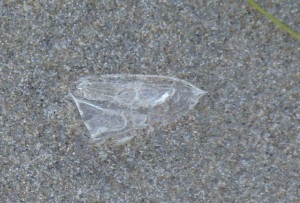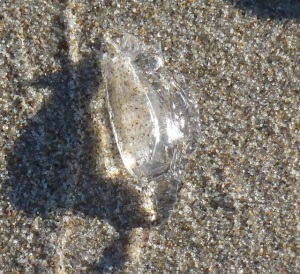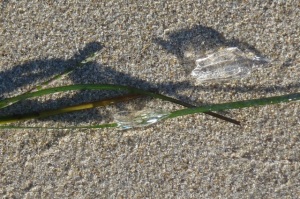 How do you explain a salp? Especially when you find one or more stranded on a sandy beach and don’t know what it is? To start with, a salp is a tunicate (I’m sure that doesn’t mean much to most). Let’s try this. It’s a gelatinous sea animal that looks like a tiny, water-filled, plastic bag. (It feels more like plastic than jelly.)
How do you explain a salp? Especially when you find one or more stranded on a sandy beach and don’t know what it is? To start with, a salp is a tunicate (I’m sure that doesn’t mean much to most). Let’s try this. It’s a gelatinous sea animal that looks like a tiny, water-filled, plastic bag. (It feels more like plastic than jelly.)  Salps are open water (pelagic) sea creatures that swim and feed at the same time — by contracting and pumping water through the body. As the water flows inside, the salp collects bits of living material, especially phytoplankton, for food. Salps can be singular, but also form long lovely chains, or colonies sometimes with many thousands of individuals (see chains in the MBARI photo or YouTube video). They’re most prominent in the waters around Antarctica, but are found in Monterey Bay, too. They’re lovely in the water, but I also found them attractive littering the sand.
Salps are open water (pelagic) sea creatures that swim and feed at the same time — by contracting and pumping water through the body. As the water flows inside, the salp collects bits of living material, especially phytoplankton, for food. Salps can be singular, but also form long lovely chains, or colonies sometimes with many thousands of individuals (see chains in the MBARI photo or YouTube video). They’re most prominent in the waters around Antarctica, but are found in Monterey Bay, too. They’re lovely in the water, but I also found them attractive littering the sand.  One of the most intriguing things about this simple-looking animal is its complex life cycle. The generations alternate from asexual single individuals producing clones to sexual colonies which include young females that age and grow into males. Offspring of the colony take up the single asexual life, hence closing the life-cycle loop.
One of the most intriguing things about this simple-looking animal is its complex life cycle. The generations alternate from asexual single individuals producing clones to sexual colonies which include young females that age and grow into males. Offspring of the colony take up the single asexual life, hence closing the life-cycle loop.  Even though salps appear jellylike, they’re not related to jellies (jellyfish) at all. This brings me back to the earlier reference to tunicates. During early larval development, salps and their tunicate relatives have a rodlike notochord, or very primitive backbone structure. (It’s not present in adulthood.) This structure also appears during the development of vertebrates (animals with backbones). That makes salps and other tunicates more closely related to you and me than to jellies.
Even though salps appear jellylike, they’re not related to jellies (jellyfish) at all. This brings me back to the earlier reference to tunicates. During early larval development, salps and their tunicate relatives have a rodlike notochord, or very primitive backbone structure. (It’s not present in adulthood.) This structure also appears during the development of vertebrates (animals with backbones). That makes salps and other tunicates more closely related to you and me than to jellies.  When I first saw these on the beach, I didn’t know what they were. They didn’t look like their living selves. (My thanks to George Matsumoto of MBARI for identifying them, and any errors in this post are mine.) The photos of these inch-long (2.5 cm) individuals and small groups were taken during a warm Sunday morning walk along Del Monte Beach (Monterey) in December. The salps may have been dumped by a current as they fed near the surface nearshore or rolled ashore on a set of large swells. However they ended up on the beach, they offered me a glimpse of the open-water world beyond the waves. Note: Salps are not dying in record numbers and littering the seafloor due to Fukushima radiation, as has been reported on the Internet. For more about the true story, see the MBARI article or Deep Sea News post.
When I first saw these on the beach, I didn’t know what they were. They didn’t look like their living selves. (My thanks to George Matsumoto of MBARI for identifying them, and any errors in this post are mine.) The photos of these inch-long (2.5 cm) individuals and small groups were taken during a warm Sunday morning walk along Del Monte Beach (Monterey) in December. The salps may have been dumped by a current as they fed near the surface nearshore or rolled ashore on a set of large swells. However they ended up on the beach, they offered me a glimpse of the open-water world beyond the waves. Note: Salps are not dying in record numbers and littering the seafloor due to Fukushima radiation, as has been reported on the Internet. For more about the true story, see the MBARI article or Deep Sea News post.
Also check out this article with beautiful images and video of salps’ feeding in Oceanus Magazine: Salps Catch the Ocean’s Tiniest Organisms.

Nice Article!
LikeLike
I have no idea, but will keep my eyes open as I scan the sand.
LikeLike
Neither. The floating sea snails eat salps, and I’ve only ever seen them together. I wonder what the remnant shell looks like out of water. For another link: http://tolweb.org/Carinaria_japonica/28750
LikeLike
Glad I could help.
Chris
LikeLike
Finally – someone has explained to me what those little jelly-like things are. Thanks for posting this! — Jean
LikeLike
Good thought, Katie. I don’t know. All the beached salps that I’ve found have been clear.
By sea snails, do you mean sea butterflies (which you’ve seen my post on) or hooded nudibranchs which I blogged about earlier last year (http://wp.me/p2Vy3B-B2)? While kayaking, I haven’t seen either in the water, just abandoned on the beach. Chris
LikeLike
I wonder if the gut always gets lost once salps wash ashore. Did you also spot any floating sea snails? http://natureid.blogspot.com/2012/03/floating-sea-snail-032912-coast-guard.html
LikeLike